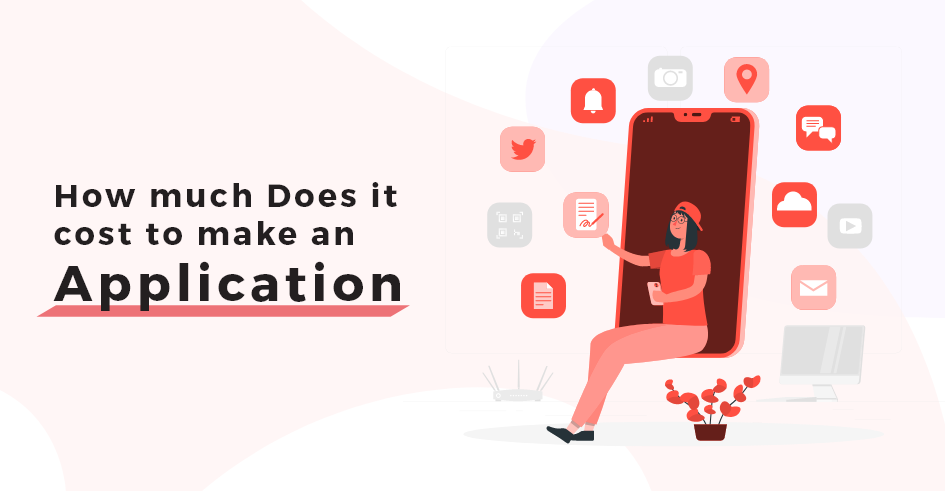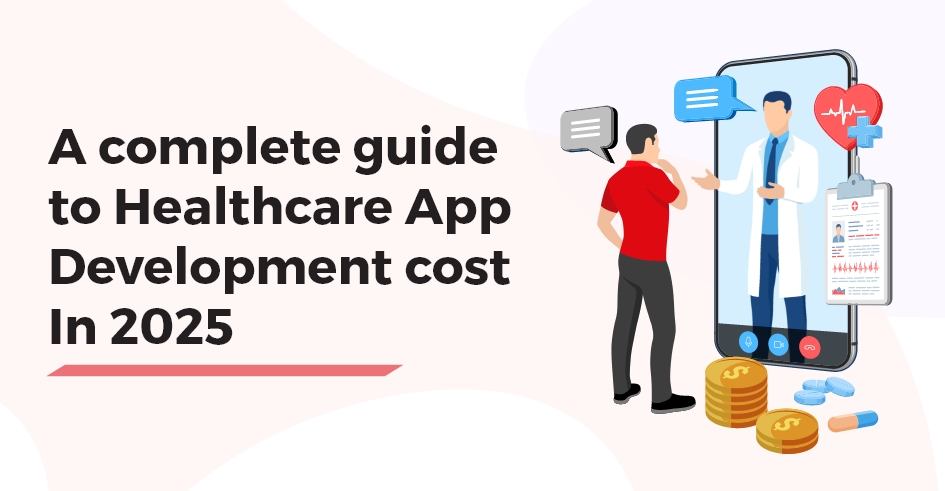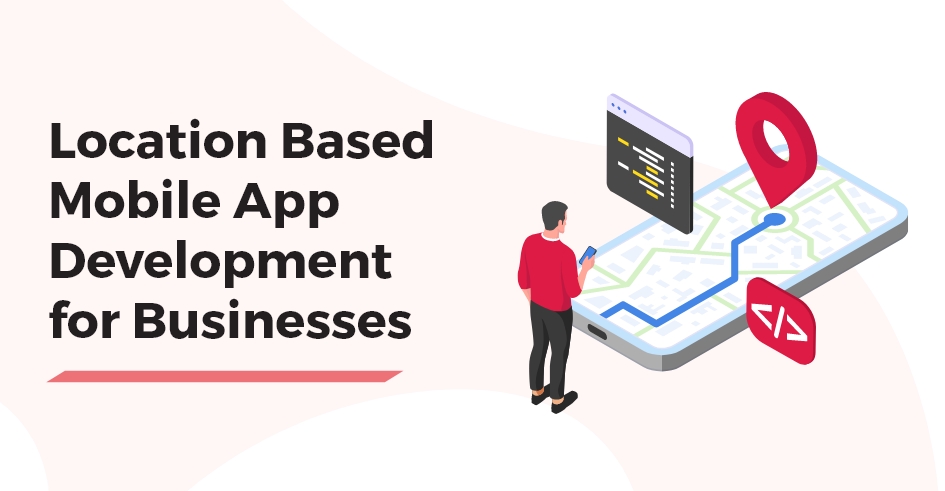In a world full of bright ideas, some of the best ones turn into mobile apps that we use every day. You have seen those apps with over a thousand downloads, and you might have your idea that could be the next big thing.
During the first quarter of 2024, users downloaded around 25.6 billion applications from Google Play. On the other hand, the number of mobile app downloads from the Apple App Store was about 8.4 billion.
Downloads are just one part of the equation, The real question is: “What will the app development cost be in 2024?”
App development costs range from $10,000 to $50,000 for a simple mobile app, and can go up to $1,000,000 for more complex or advanced apps.
If you are curious about this exciting world of app development, you are in the right place. We are here to break it down for you in simple terms so you can understand how much it costs to turn your idea into a real app. The world of app development has room for everyone, from regular folks with great ideas to big businesses looking to innovate.
Your idea could change lives, make tasks easier, or even start a completely new trend. In this journey, we will help you explore the world of app development costs. We will make it easy to understand so you can get a grip on what it takes to turn your idea into an app that people will love. So, get ready to dive into the world of app development, where your ideas can become real digital wonders.
Protecting Your Idea
You’ve got a fantastic idea for an app, and you’re eager to dive into the world of app development. But before you take the plunge, it’s crucial to consider how to protect your idea. One way to do that is by patenting your app concept. You can also read our guide for how to patent an app idea to get more insights on protecting your app idea. By securing your intellectual property rights, you ensure that your unique idea remains your own. While patenting may add to your initial expenses, it’s a vital step in safeguarding your vision.
Creativity is the Key to App Development
As you ponder the cost of making an app, it’s essential to keep those creative wheels turning. Your initial idea might evolve, or you might come up with new features and functionalities along the way. Keeping your idea fresh and adaptable can lead to a more successful app. Innovation is an ongoing process, and your app’s success might depend on staying open to new possibilities.
How Much Does It Cost to Build an App?
Wondering “How much does it cost to develop an app in 2024”? The cost of app development hinges on the complexity of your project. In 2024, three broad categories define this complexity:
| App Complexity |
Description |
Cost Range |
Development Timeframe |
Examples |
| Simple Apps |
Basic features like user registration and simple UI |
$30,000 – $50,000 |
4.5 – 11 weeks |
Flashlight, Weather apps |
| Complex Apps |
Advanced features like real-time updates and UI |
$100,000 – $250,000+ |
7 – 16 weeks |
Social Media, E-commerce apps |
| Advanced Apps |
Highly intricate features like AI and virtual reality |
$250,000 – $1,000,000+ |
11.5 – 16 weeks |
Healthcare, Enterprise-level apps |
1. Simple Apps
Developing a basic app in 204 could cost anywhere between $15,000 and $50,000. A simple app usually includes features like a user interface, user registration and login, and basic functionality and takes 4.5 to 11 weeks to develop. Examples of simple apps include flashlights, calculators, and weather apps.
2. Complex Apps
Developing a complex app in 2024 can cost between $100,000 and $300,000 or even more. A complex app usually has advanced features such as real-time updates, push notifications, third-party integrations, and advanced user interfaces. The development time for a complex app can range from 7 to 16 weeks. Technologies like the Internet of Things (IoT) and Augmented Reality (AR) are often integrated into complex apps, enhancing their functionality but also increasing development time and cost. An App like Snapchat, e-commerce apps, and gaming apps are perfect examples of complex apps.
3. Advanced Apps
On the other hand, developing an advanced app in 2024 can cost between $300,000 and $1,000,000 or more. Advanced apps typically have highly complex features such as Artificial Intelligence (AI), Blockchain Development, and machine learning. The development time for an advanced app can range from 11.5 to 16 weeks. Apps that leverage AI for predictive analytics or Blockchain for secure transactions fall under this category. Healthcare apps, fintech apps, and enterprise-level apps are all covered in advanced apps.
Can I make an app by myself?
Creating an app all by yourself is possible if you have enough technical knowledge and expertise. However, in most cases, app development is not a one-person task. It involves a team of developers or you may hire app developers, UI/UX designers, project managers, and quality assurance engineers who work together to turn your idea into a fully functional app. The duration of this process is usually 3-6 months, depending on the number and complexity of features.
Now, let’s delve deeper into the process of finding out the cost of building an app.
Factors That Affect App Development Cost
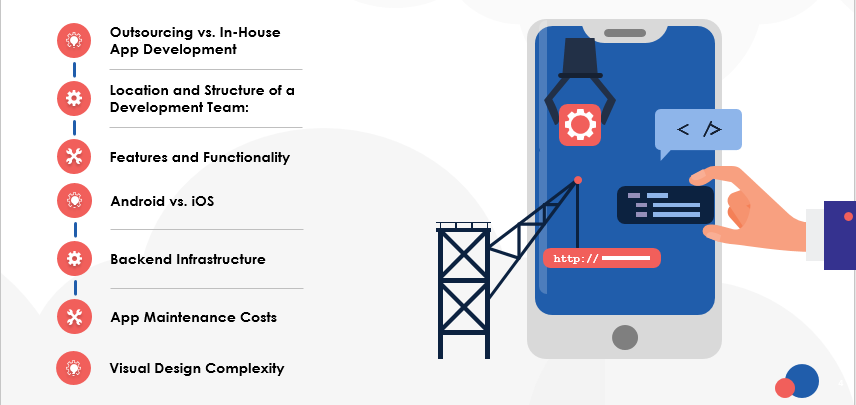
Understanding the expenses associated with app development is a multifaceted endeavor. The ultimate cost of bringing your app idea to life hinges on a myriad of influential factors. Let’s take a closer look at the key determinants that significantly impact the financial aspects of app development:
1. Outsourcing vs. In-House App Development
When developing an app, you must decide whether to use an in-house team or to outsource the process to a third-party agency. Choosing an in-house team provides a significant advantage in terms of direct communication and complete control over the development process. Lets take a look at them below:
| Aspect |
Outsourcing App Development |
In-House App Development |
| Direct Control |
Limited |
High |
| Proximity |
Geographical separation |
Local |
| Communication |
Virtual and remote |
Face-to-face meetings |
| Talent Pool |
Wide talent pool |
Local talent constraints |
| Initial Investments |
Lower initial investments |
Higher initial investments |
| Hiring and Bureaucracy |
Reduced administrative tasks |
Administrative responsibilities |
| Time Zone Differences |
Potential time zone challenges |
No time zone issues (local) |
| Expertise Levels |
High expertise levels |
Dependent on in-house team expertise |
| Flexibility |
High |
Relatively lower |
| Cost Flexibility |
Cost-effective |
Cost constraints |
| Need for High Seed Money |
Not required |
Required |
In-House Development: Opting for an in-house development team offers advantages such as direct communication and full control over the development process. However, it often involves challenges like talent shortages, substantial initial investments, and dealing with hiring and bureaucratic complexities.
Outsourcing: Choosing to outsource app development provides access to an extensive talent pool, high expertise levels, cost-effectiveness, flexibility, and the elimination of the need for substantial initial investments. While it might entail some disadvantages, such as time zone differences and a lack of personal control, the benefits often outweigh the drawbacks.
2. Location and Structure of a Development Team:
If you decide to outsource app development, you will need to choose a country to outsource to. There are several options available:
Nearshore Outsourcing: This strategy involves collaborating with a development company from your own country or a nearby one, with a minimal time zone difference of 2-4 hours. Nearshore outsourcing offers the advantage of relative geographic proximity, which can facilitate real-time communication and collaboration.
Offshore Outsourcing: Offshore development extends to companies located anywhere in the world, often spanning more than four time zones. While this approach can pose challenges related to time zone differences and less direct control, it is often favored due to its significant cost advantages. Many companies choose offshore development to leverage lower labor costs and access a diverse talent pool while managing to maintain effective communication through careful selection of development partners with overlapping working hours.
| Region |
iOS
(Avg. $/Hr) |
Android
(Avg. $/Hr) |
Cross-Platform
(Avg. $/Hr)
|
| Canada |
90 – 120 |
80 – 140 |
90 – 120 |
| The USA |
60 – 120 |
60 – 120 |
60 – 130 |
| Latin America |
28 – 90 |
28 – 90 |
40 – 160 |
| The UK |
60 – 75 |
60 – 75 |
55 – 75 |
| Europe |
35 – 55 |
35 – 55 |
30 – 50 |
| Ukraine |
40 – 78 |
38 – 60 |
40 – 78 |
| South Africa |
45 – 80 |
40 – 80 |
40 – 80 |
| India |
22 – 90 |
15 – 25 |
20 – 30 |
| Southeast Asia |
23 – 55 |
30 – 45 |
30 – 45 |
| Asia |
25 – 35 |
20 – 30 |
25 – 35 |
| Australia |
90 – 120 |
100 – 120 |
90 – 120 |
3. Features and Functionality
The features and functionality of your app are paramount when it comes to cost estimation. This crucial aspect can significantly impact both the complexity of the development process and the final expenses involved. To understand the role of features in app development costs, let’s delve into the details:
Complexity and Variety of Features:
The more intricate and diverse the features you plan to incorporate into your app, the more intricate and time-consuming the development process becomes. Features such as real-time updates, third-party integrations, push notifications, advanced user interfaces, and other advanced functionalities can substantially increase development expenses. These complex features often require more extensive coding, testing, and fine-tuning.
Customization and Uniqueness:
Custom features, designed to meet specific and unique requirements, typically demand a higher level of expertise and development effort. Customization can add both to the time and cost of development, as developers need to design, code, and thoroughly test these tailored elements to ensure they function seamlessly within the app.
Integrations and Compatibility:
Features that involve integrating with external systems, services, or APIs can drive up development costs. Such integrations require in-depth technical expertise, comprehensive testing, and ongoing maintenance to ensure compatibility and functionality.
User Interface Design:
The sophistication of the app’s user interface also plays a significant role in cost determination. Elaborate and visually appealing interfaces, rich in animations and user-friendly design, tend to require more development effort. Achieving a high level of design finesse often involves additional design and development hours.
To illustrate the impact of features on development costs, here’s a table summarizing how different types of features can influence your project:
| Type of Feature |
Influence on Cost |
Description |
| Basic Features |
Moderate |
Standard functionalities like user registration and basic user interface design, with limited additional complexity. |
| Real-time Updates |
Significant |
Implementing features that require real-time data synchronization and constant updates can drive up costs. |
| Third-Party Integrations |
Significant |
Integrating with external services, APIs, or databases can be complex and entail additional development efforts. |
| Push Notifications |
Moderate |
Implementing push notifications, while common, requires precise coding and testing. |
| Advanced User Interfaces |
Significant |
Complex, visually-rich user interfaces with intricate animations and interactions can substantially increase costs. |
It’s essential to work closely with your development team to determine the specific features your app will require. A well-defined feature list enables precise cost estimation, effective project management, and the successful execution of your app development project.
4. Android vs. iOS
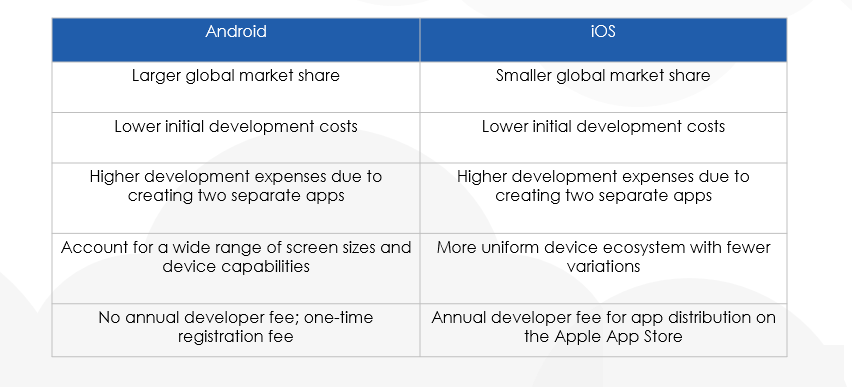
When venturing into app development, one of the foremost decisions you’ll face is choosing the platform or platforms on which your app will operate. The primary contenders in this arena are Android app development and iOS app development, each with its unique set of advantages and challenges.
Platform Overview
Android: This platform, developed by Google, powers a vast array of devices. It boasts a larger global market share, making it an attractive option for reaching a broad audience. The Android ecosystem is diverse, supporting numerous device manufacturers and versions of the operating system.
iOS: Apple’s iOS platform, on the other hand, is known for its user-friendly, premium devices. The iOS user base is generally more homogeneous, as Apple controls both hardware and software. While iOS app development enjoys a significant market share in certain regions, it is typically more prevalent in North America and Europe.
Development Costs:
Choosing between native and hybrid development depends on project requirements, budget and app vision. It’s a critical decision that impacts success, so consider carefully.
Native App Development: This approach involves crafting an application tailored specifically for a single platform—either iOS or Android. While native apps offer unparalleled performance and user experience, they come with a catch: if you aim to target both platforms, you’ll need to create two distinct apps. This inherently escalates the overall app development cost.
Hybrid App Development: On the flip side, hybrid app development is all about versatility. These apps are engineered to function seamlessly on multiple operating systems, which can significantly reduce your app’s development expenses. However, this cost-efficiency comes with its own set of challenges. Hybrid apps may exhibit unstable performance, a variable user experience depending on the device in use, and certain technical limitations.
Platform-Specific Considerations
Fragmentation (Android): Developing for Android can be more complex due to the platform’s fragmentation. You need to account for a variety of screen sizes, resolutions, and device capabilities. This can lead to additional design and testing efforts.
App Store Fees (iOS): When releasing an app on the Apple App Store, you’ll need to pay an annual developer fee. This cost is absent from Android app development, where publishing on the Google Play Store has a one-time registration fee.
To help clarify the cost implications, here’s a table summarizing the key aspects of Android and iOS app development:
| Aspect |
Android |
iOS |
| Platform Market Share |
Larger global market share |
Smaller global market share |
| Development Costs (Single Platform) |
Lower initial development costs |
Lower initial development costs |
| Developing for Both Platforms |
Higher development expenses due to creating two separate apps |
Higher development expenses due to creating two separate apps |
| Fragmentation |
Account for a wide range of screen sizes and device capabilities |
More uniform device ecosystem with fewer variations |
| App Store Fees |
No annual developer fee; one-time registration fee |
Annual developer fee for app distribution on the Apple App Store |
Android App Development can Cost between $5,000 to $50,000, widely depending on the features, complexity and the development team’s location. As for the iOS App Development cost, it is around $10,000 to $100,000+.
5. Visual Design Complexity
When it comes to app development, the visual design of your application is not just about aesthetics; it’s a fundamental element that can substantially impact the overall cost. Let’s delve deeper into the role that visual design complexity plays in shaping the financial aspects of your app development journey.
- High-Quality Custom Designs:
When you envision a visually stunning app with intricate, tailor-made designs, expect that such aesthetics will come at a price. Custom designs involve the creation of unique graphics, icons, and user interface elements that perfectly match your app’s concept. This meticulous work requires the skill and time of talented designers, resulting in higher development expenses. The intricate nature of these designs contributes to both the cost and time aspects of development.
- Animations and Interactive Elements:
If your app calls for animations, transitions, or interactive elements that provide users with a dynamic and engaging experience, be prepared for added development costs. Creating smooth, seamless animations and interactive features demands not only design expertise but also intricate coding and testing to ensure everything functions flawlessly. These dynamic elements, while enhancing user engagement, can increase the complexity and thus the cost of development.

Apps with intricate user interfaces, characterized by multiple layers, interactive components, and advanced functionalities, often require a significant investment. These interfaces, while offering a rich user experience, necessitate more development time and expertise, which directly translates to higher costs.
- Simple and Straightforward Designs:
On the other hand, if your app’s design adheres to simplicity and straightforwardness, you can enjoy cost-efficiency. Minimalistic designs with clean lines, basic color schemes, and uncomplicated user interfaces are more straightforward to create, resulting in reduced development expenses. While they may not possess the visual flair of highly complex designs, these simpler designs can be both budget-friendly and user-friendly.
6. Backend Infrastructure
The backend infrastructure, including databases, servers, and the technical framework supporting your app, plays a substantial role in determining costs. Complex backend systems, such as those incorporating artificial intelligence or real-time data processing, typically require more extensive development work and, subsequently, increased expenses.
7. App Maintenance Costs
While determining the initial cost of developing an app is crucial, it’s equally essential to comprehend that expenses extend beyond the app’s deployment and market launch. App maintenance is a recurring necessity that requires financial preparedness.
As per insights from GoodFirms, the annual expenditure for app maintenance is estimated to be around $21,000. However, it’s vital to understand that the financial commitment doesn’t diminish once the app is live; it evolves over time.
Research reveals that approximately 50% of the app development cost will be allocated to maintenance during the first year. Subsequently, for the second year, the financial allocation drops to roughly 25%. As the app matures, you can anticipate spending between 15% to 25% of the initial development cost for each subsequent year (data sourced from Outsystems, 2018-2019).
So, what exactly does app maintenance encompass?
- Bug Fixing and Quality Assurance: Ensuring that your app remains free of bugs and maintains a high level of quality is an ongoing task. This involves identifying and rectifying issues to enhance the user experience.
- Stability and Performance Improvements: As technology evolves, your app should evolve with it. Regular updates are required to enhance the stability and performance of your app, ensuring it remains competitive in the market.
- Code Optimization: Optimizing the app’s code is a continuous effort to improve its efficiency and reduce resource consumption.
- Upgrade to the Latest OS Versions: Operating systems evolve, and your app must keep up. Regular updates are essential to ensure compatibility with the latest OS versions.
- Implementation of New Features: To stay relevant and appealing to users, implementing new features and functionalities is a part of app maintenance. This involves planning and development efforts.
- Support of the Latest Version of 3rd Party Services: Many apps rely on third-party services, and these services may update or change over time. Ensuring seamless integration and functionality often requires updates and adaptations.
When allocating your budget, it’s imperative to allocate resources not only for the initial development but also for ongoing app maintenance. This bifurcation allows you to ensure the longevity and success of your app in a dynamic and ever-evolving digital landscape.
Mobile Apps Cost By Category
The app development world offers endless opportunities across various industries. Whether it’s healthcare, education, entertainment, or any other field, there’s likely an app idea waiting to be discovered. Take some time to explore different industries and consider how your app concept might fit in. By branching out beyond your initial vision, you might stumble upon an industry with vast potential.
In the vast landscape of app development, opportunities span across a multitude of industries. Think of it as an expansive playground where creativity knows no bounds. Whether you’re intrigued by healthcare, education, entertainment, or any other sector, there’s a high likelihood that your app idea has a place within it. Take some time to embark on a journey through different industries, envisioning how your app concept might find its unique role.
|
Industry
|
Estimated App Development Cost |
|
Education app development cost
|
$25,500 to $50,000
|
|
Healthcare app development cost
|
$50,000 to $100,000 |
| Real Estate app development cost |
$85,000 to $100,000
|
|
Retail app development cost
|
$10,000 to $150,000 |
|
Automotive app development cost
|
$25,000 to $50,000 |
| SaaS App development cost |
$15,000 to $300,000
|
| AI App development cost |
$20,000 to $150,000
|
|
IoT app development cost
|
$20,000 to $150,000 |
| AR app development cost |
$30,000 to $300,000
|
|
Blockchain app development cost
|
$40,000 – $300,000 |
|
Entertainment app development cost
|
$5,000 to $70,000
|
| E-commerce app development cost |
$30,000 to $60,000+
|
|
Fintech mobile apps cost
|
$10,000 to $200,000 |
| Hotel mobile app development cost |
$25,500 to $50,000
|
|
Manufacturing app development cost
|
$15,000 to $50,000. |
| Travel booking app development cost |
$60,000 to $150,000
|
|
Health and Fitness app development cost
|
$5,000 to $15,000.
|
| Logistics app development cost |
$10,000 to $35,000
|
The education sector is ripe for app innovation. From personalized learning platforms to interactive study tools, mobile learning apps are changing how we acquire knowledge and skills. These apps tailor learning experiences to individual needs, making education more accessible and engaging.
Healthcare apps have the power to transform patient care and administrative tasks. They can help with telemedicine app development, streamline appointment scheduling, monitor vital signs remotely, and improve the quality and accessibility of healthcare services.
Real Estate Mobile App Development
Real estate apps help users buy, sell, or rent properties online. They often feature property listings, virtual tours, and location details. These apps simplify communication between agents and buyers. The development includes integrations for maps and payment gateways. Real estate apps are becoming essential in the housing market.
Retail app development
Apps in Retail are changing the way we shop, enhancing in-store experiences and streamlining online purchases. Retail app development can provide personalized recommendations or simplify the checkout process, making shopping more convenient and enjoyable.
Automotive App Development
Automotive apps are used for vehicle tracking, diagnostics, and maintenance. They offer features like GPS navigation and real-time vehicle status updates. Some apps connect to cars for remote control or data analysis. Automotive apps are crucial for managing fleets and improving driver safety. They also enhance the overall driving experience.
SaaS App Development
SaaS apps provide software services over the cloud that are accessible anytime. They’re subscription-based and can range from productivity tools to business management platforms. SaaS apps reduce the need for complex installations. They are scalable, secure, and easily updated, helping businesses cut down on IT costs.
AI App Development
AI apps use machine learning and algorithms to automate tasks. They offer personalized recommendations, chatbots, and predictive analytics. AI can improve decision-making and optimize processes. Development includes training AI models with large datasets. AI apps are used in the healthcare, finance, and customer service industries.
IoT App Development
IoT apps connect smart devices to the internet for real-time control and monitoring. They manage devices like smart thermostats, cameras, and wearables. IoT apps improve home automation, healthcare, and logistics, and their demand is growing with more smart devices.
AR App Development
AR apps blend digital elements into the real world using the device’s camera. They are used for games, virtual shopping, and education. AR enhances user experience by making interactions more immersive. These apps require advanced image recognition and 3D modeling. AR is transforming industries like retail, gaming, and real estate.
Blockchain App Development
Blockchain apps ensure secure and transparent transactions through decentralized systems. They are often used for cryptocurrency exchanges, supply chain tracking, and smart contracts. Blockchain’s immutability makes these apps highly reliable. Development involves cryptography and distributed ledgers. Blockchain apps are shaping the future of finance and security.
Entertainment app development
Entertainment apps encompass gaming, content streaming, event planning, and more. They have the potential to create engaging experiences, help users discover new forms of entertainment, and make leisure time more enjoyable.
E-commerce app development
E-commerce apps play a pivotal role in modern retail. They can enhance the online shopping experience with features such as secure payment methods, real-time inventory updates, and personalized shopping recommendations.
Modern FinTech apps such as PayPal, Robinhood, and Stripe have become indispensable parts of our daily routines. Finance apps offer tools for budgeting, investing, and tracking expenses. They empower users to take control of their finances, offering insights and recommendations for better money management.
Hospitality mobile app development
Apps in the hospitality sector can enhance guest experiences in hotels, restaurants, and travel. Think of an app that allows guests to check in, order room service, or book activities conveniently from their smartphones.
Social media app development
Developing a social media app opens the gateway to a global stage of connections and interactions. With features designed for content sharing, networking, and engagement, these apps have the power to unite people, foster communities, and provide a platform for self-expression. Privacy and content management are pivotal concerns, making user data protection and content moderation essential aspects of development. The social media landscape thrives on innovation, offering vast opportunities for those ready to redefine the way we connect and communicate in the digital age.
How Much Does it Cost to Build an App: Calculation Techniques
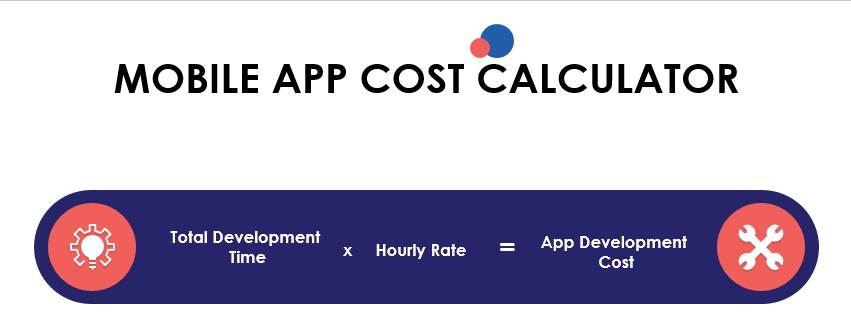
When it comes to estimating the cost of building an app, precision is key. Accurate cost calculations are vital for budgeting and resource allocation. Here are some techniques and methods used in the industry to determine the cost of app development:
Total Development Time x Hourly Rate = App Development Cost
Feature-Based Costing:
This method involves breaking down the app into individual features and functionalities. Each feature is assigned a cost based on its complexity and development requirements. The cumulative cost of all features provides an estimate of the total project cost.
Time and Materials (T&M):
T&M pricing is often used for projects where the scope is not well-defined. In this approach, the client pays for the actual time spent on development and the materials used. It provides flexibility but can be less predictable in terms of cost.
Fixed Price Model:
In this method, the development company and the client agree on a fixed price for the entire project based on the project’s scope and requirements. It provides cost predictability but may be less flexible for changes.
Expert Judgment:
Experienced app developers and project managers rely on their expertise to estimate costs. They consider factors like complexity, technology stack, design, and integration requirements. This method can be quick but may have a margin of error.
Prototyping and MVP:
Creating a prototype or a Minimum Viable Product (MVP) allows for cost estimation based on the initial development phase. This method provides a foundation for estimating the total project cost.
Historical Data:
Past app development projects with similar features and complexity can serve as a reference point for estimating costs. Historical data helps in making informed projections.
Cost Per Hour or Developer Rate:
Some companies charge based on hourly rates of developers involved in the project. Multiplying the hourly rate by the estimated development time provides the cost estimate.
Online Cost Calculators:
Several online tools and cost calculators are available, allowing users to input project details and receive rough cost estimates based on industry averages and benchmarks.
Market Research:
Researching the costs of similar apps in the market can offer insights into the budget required. It helps to gauge the competitive landscape and understand what users expect for a given price range.
Consulting App Development Firms:
Seeking consultation from app development firms like TechnBrains can provide a tailored and accurate cost estimate. These experts consider specific project requirements and industry standards.
It’s important to note that the complexity of the app, its features, technology stack, design, and other factors all influence the final cost. The choice of method depends on the project’s nature, and often a combination of techniques is used to arrive at a comprehensive and accurate cost estimate.
How do apps make money?
the mobile app industry has become a flourishing landscape, providing not just convenience and entertainment but also a plethora of opportunities for entrepreneurs and developers to turn their innovations into profitable ventures. But the fundamental question remains, “How do apps make money?” This inquiry unveils a world of strategies and monetization models, each catering to specific app types and user behaviors.
So, ‘How do apps make money?’ The answer might be through different App strategies and monetization models, each tailored to specific app types and user behaviors.
1. In-App Advertising:
One of the most common revenue streams for free apps is in-app advertising. Apps display ads to users, and the app owner earns money based on user interactions or impressions.
2. Freemium Model:
Under this model, apps offer a free version with basic features and the option to upgrade to a premium, paid version with additional functionalities. Users who desire enhanced experiences can opt for in-app purchases.
3. In-App Purchases:
Apps can offer a range of virtual or physical goods for sale within the app. This includes digital products, subscriptions, or even physical merchandise. Users pay to access these items.
4. Subscription Models:
Many content-based apps employ subscription models, offering users premium content for a recurring fee. Examples include streaming services, news apps, and fitness apps.
5. Affiliate Marketing:
Some apps generate income by promoting other companies’ products or services. When users click on affiliate links within the app and make a purchase, the app owner earns a commission.
FAQs
How much does app development cost?
The cost of app development varies with project complexity. Basic apps typically range from $5,000 to $10,000, while complex apps can cost $50,000 to $75,000 or more.
What’s the development timeline?
In most cases, app development takes a minimum of three months, with approximately 40% of projects extending beyond six months.
What are mobile app maintenance costs?
Mobile app maintenance costs are roughly $21,000 annually, with 50% of the initial development cost spent in the first year, about 25% in the second year, and 15%-25% for subsequent years.


